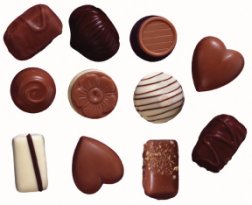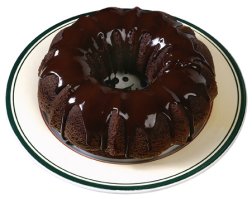Leaden Chocolates
Here’s something that might give you pause after Halloween: Chocolates are among the more lead-contaminated foods. A new study has probed the source of chocolate’s lead and concludes it’s not the cocoa bean. Its concentrations of the toxic metal were among the lowest recorded for any foodstuff.



The issue of lead-tainted chocolates is hardly new. Indeed, it was the basis of a 2002 lawsuit brought in California. That suit against chocolate makers was withdrawn, however. The new study, which appears in the October Environmental Health Perspectives, was triggered by that litigation. The litigants that commissioned the testing had hoped the researchers would identify the source of the candy’s lead.
Even after completion of the study, however, the major source remains unidentified, notes study leader Charley W. Rankin of the University of California, Santa Cruz. That’s too bad, the environmental chemist says, because since it’s nevertheless obvious that most of chocolate’s lead isn’t from cocoa beans when they’re picked, the contaminant should be easy to eliminate—once scientists pin down at what stage of chocolate production it originates.
How serious is the lead problem? “I’m not going to suggest that you curb your chocolate consumption,” says Rankin. For most people, he says, the amount of lead in even the more-tainted chocolates isn’t high enough to cause health problems. However, he worries, for young children or elderly individuals living with lead-tainted pipes or paint, eating lots of chocolate could aggravate health risks by offering an unnecessary additional source of the metal.
Most other people, he says, can take heart in the many research studies suggesting that the constituents of chocolate offer a host of health benefits. Indeed, Rankin concludes, unless taken in excess, “chocolate may actually be pretty good for you” (SN: 3/18/00, p. 188).
Spongy husks
The shell of cocoa beans is a remarkably efficient sponge for lead. It can tightly bind the metal, preventing it from reaching the interior bean. That explains, Rankin says, why samples of shells from Nigeria, where beans were sampled, contained so much lead—between 60 and 417 nanograms per gram. That’s at least 300 times as much lead as was in the beans inside, Rankin says.
Researchers at the University of Quebec have published findings over the past few years confirming the particularly efficient uptake and storage of lead by cocoa shells, or husks. The husks are so effective that researchers have begun exploring them as the basis of a new industrial system for removing metals from industrial wastes.
Because Nigeria is among countries that still use octane-boosting lead additives in gasoline, it’s possible that airborne lead from fuel might have settled onto shelled cocoa beans that were left outside to dry and then sampled in the recent study.
However, Rankin points out, the overall lead increase in beans was small while they were drying, so most lead enters the chocolate-making process further downstream. The finding that cocoa beans leave the farms with low lead concentrations is also consistent, he says, with his team’s finding that “there’s not that much lead contamination of the soils” in Nigeria’s cocoa-growing regions, which should also reflect impacts of leaded-fuel use in the area. In fact, U.S. soils along roadways are much more tainted by decades of cars’ use of leaded gasoline, he notes.
As environmental toxicologists, Rankin says, his team had expected that leaded gasoline would prove a major contributor to chocolate’s lead contamination—and that such a finding might offer strong economic ammunition for phasing out the heavy metal’s addition to fuel in cocoa-growing countries. However, he says, his team’s data just don’t support that scenario.
Bittersweet findings
The new study shows that dark chocolates, including bittersweet and semisweet candies, had the highest lead concentrations—roughly 30 to 70 nanograms of the heavy metal per gram versus just 11 to 35 ng/g in milk chocolate. Dark chocolates are the types frequently used in gourmet confections and in most chocolate chip cookies. They also contain the highest concentrations of heart-friendly chemicals (SN: 3/18/00, p. 188).
The reason for the dark-chocolate–lead correlation is simple, Rankin says. These chocolates have more cocoa per gram of finished product than do milk chocolates. This fact also explains why unsweetened baking chocolates and cocoa powder, which have the highest concentration of cocoa per manufactured product, topped the lead list. Cocoa powders tested by the team had 150 to 190 ng/g of lead; baking chocolates tended to average roughly 250 ng/g.
However, Rankin notes, candies aren’t the only items affected. Studies have shown that even chocolate pudding will have more lead than a vanilla pudding does.
It’s legal
In May 2002, the American Environmental Safety Institute (AESI)—a California-based nonprofit group—filed a lawsuit against chocolate companies charging “various breaches of duties associated with their exposure of hundreds of thousands of California citizens to toxic lead and cadmium contained in various chocolate products manufactured and sold by [those companies].” AESI argued that the companies were violating consumer health–protection provisions of a California law known as Proposition 65 (SN: 9/2/00, p. 152).
The suit claimed that these companies “know, while the general public does not, that a number of their products contain lead and cadmium, which are poisonous metals …. While the quantities of these poisons in Defendants’ products are small in an absolute sense, they are significant in relation to the total intake that children under six get from all food sources . . . . They are also significant in relation to the warning-requiring levels set under the Safe Drinking Water and Toxic Enforcement Act of 1986 . . . (popularly known as Proposition 65).”
AESI also charged that the candy companies “have not done all they could to minimize the amounts of lead and cadmium in their products . . . [by bringing] about changes in growing, cultivation, storage, processing and quality control concerning chocolate products . . . .”
In a separate action, AESI petitioned the State of California to find such companies in violation of Proposition 65—a move that the government ultimately rejected. In a letter to attorneys in the suit, the state argued that the law “does not apply to low levels of chemicals in foods that are deemed ‘naturally occurring,'” which Attorney General Bill Lockyer’s office said clearly appeared to be the case with chocolate.
As part of its lawsuit against the candy manufacturers, AESI hired the University of California, Santa Cruz team to do lead analyses of chocolate products and constituents. However, Rankin recalls, his group warned AESI that “we’re not going to guarantee our data will say what you want it to. We’ll just get objective data.” As the researchers began planning their studies, they decided to expand their inquiries into a broader project looking at lead in chocolate—largely removed from the objectives of the litigation. In the end, he says, most of the money to fund this work came from unrestricted grants to the university from sources other than AESI.
Ultimately, AESI’s lawsuit never went to trial, says Michèle B. Corash, a San Francisco-based attorney representing the candy companies. “On the eve of trial, the plaintiffs [AESI] threw in the towel,” says Corash. Representatives of AESI didn’t respond to a request for comments for this article.
The bottom line for consumers in California and elsewhere is that current concentrations of lead typical of U.S. chocolate products, while high compared with those in other foods, remain quite legal.
Lead—all natural?
Lead usually occurs as a mix of different isotopes, each of which has slightly different constituents in its atomic nuclei and therefore slightly different weights. Depending on where any given sample of lead comes from, it can contain a different—and potentially unique—ratio of lead isotopes.
The Santa Cruz team tried to probe whether the lead-isotope ratios in cocoa beans, their husks, cocoa-farm soil, and chocolate candy were all the same. If not, this would suggest the lead from each entity came from various sources—perhaps leaded gasoline, a metal smelter, or even contaminants in fertilizers and other agricultural amendments. The new paper reports that overall, the picture was muddy, indicating no one major common source of lead. However, significant overlaps did exist between samples, suggesting that some share of the lead in each might trace to a common factor.
In essence, the new study couldn’t prove that the lead in chocolate isn’t naturally occurring, Corash says. This finding meant AESI had few grounds for arguing under Proposition 65 that chocolate manufacturers had adulterated or otherwise created unsafe products. Indeed, Corash contends, any lead is chocolate most likely comes from its contamination with some of the lead-laden husk.
Rankin doesn’t challenge that traces of husk can end up in the finished cocoa. Indeed, the U.S. Food and Drug Administration allows husk material to constitute up to 3 percent of the finished chocolate.
However, he adds, lead-laden husks can’t explain all of the lead that his team found in finished chocolate. Why? Because “if you take the [lead] concentration typical of cocoa-bean shells and tried to apply it to what you find in the finished product, your product would have to consist of 104 percent cocoa-bean shell”—a physical impossibility.
To the Santa Cruz scientists, the interesting question has become: At which point does most of the lead enter constituents of chocolate—in the field, after harvest, during shipping, during some other stage? At present, they have no answers.
Nevertheless, Rankin says that their chocolate investigations amounted to some fun and toxicologically-relevant food chemistry.







